When most people think of a daddy long legs, they think of the most dangerous spider in the world that has mouth parts that are too small to bite through human skin.
If you think you have seen one, continue reading to find out what spiders look like daddy long legs.
Table of Contents
What Are Daddy Long Legs?
What may surprise you is that a daddy long legs is not a spider or a fly, they are long-legged creatures, known as harvestman and have distinct differences to common spiders.
The daddy long legs only have two eyes, whereas spiders have six to eight eyes. They also only have one body part, which is usually oval, whereas spiders have two defined body segments. Their legs can be up to thirty times longer than their body.
Their legs help them hear vibrations when there is a predator heading towards them or they are getting closer to their prey.
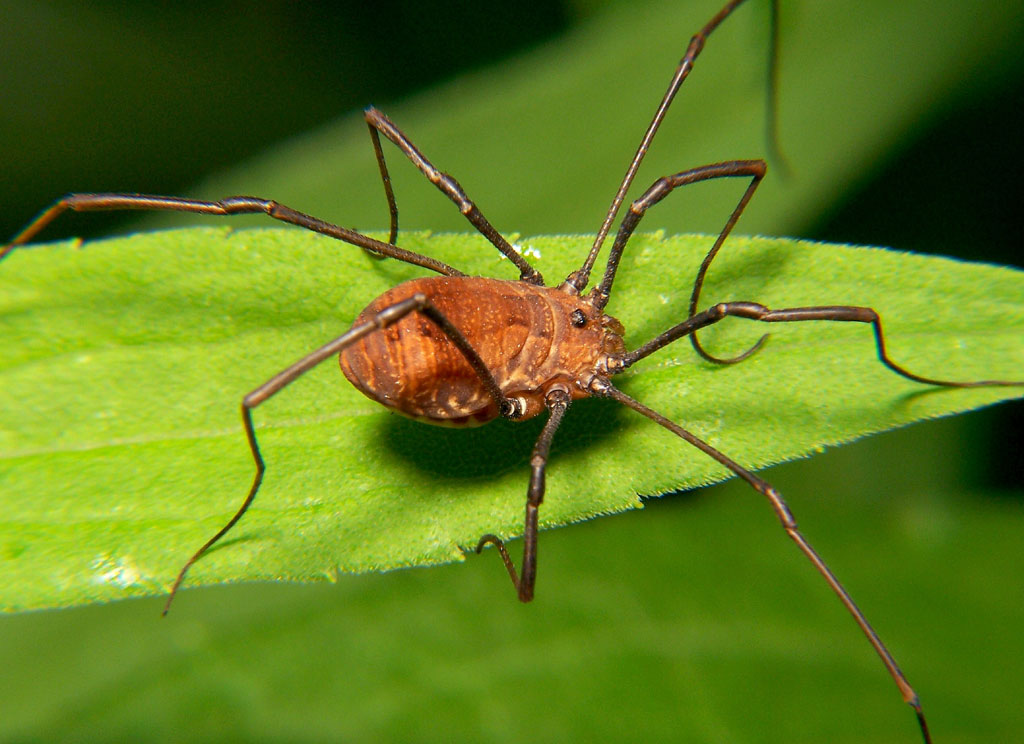
9 Spiders That Look Like Daddy Long Legs
You will come across some spiders that look just like the daddy long legs. Continue reading below for the 9 spiders that look like daddy long legs.
1. Long-bodied Cellar Spider

The Long-bodied Cellar Spider (Pholcus phalangioides) has gained the nickname, the daddy long legs spider with females being slightly larger than the male. These spiders have long and thin legs, covered in thin gray hairs. Their long legs are around six times longer than their bodies.
A female can grow to a 50mm leg span with a body of 10mm in length. Their bodies are in two segments, the cephalothorax or head space and the abdomen. The long-bodied cellar spider has a peanut shape on the cephalothorax, which has also given it the name skull spider.
Their brown to pale gray bodies have a dark spot on the cephalothorax and blurred spots on the cephalothorax. Their eight eyes are arranged with two small eyes at the front and three rows of larger eyes.
These spiders often make their way indoors, where they hide in dimly lit areas which are quiet. Those outdoors, are often found in crevices and caves.
2. Marbled Cellar Spider
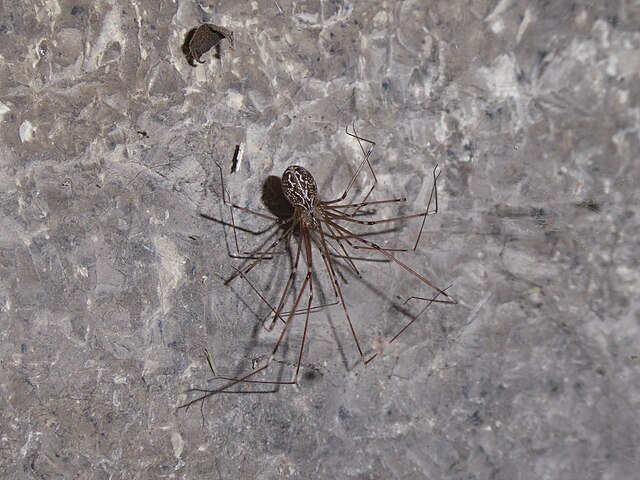
Marbled Cellar Spiders (Holocnemus pluchei) are also referred to as daddy long legs. They can be found throughout the United States, North Africa, and Europe. They are common household visitors, building nests in basements, attics, and eaves on houses.
Some live in solitary webs, while others join existing webs. There is very little size difference between the male and female, both with long and fragile legs that have black and white circles at the joints.
Marbled cellar spiders are considered urban pests, building their webs in basements and walls of buildings. They prefer warm areas, hiding in caves, basements, and under rocks.
3. Tailed Cellar Spider

Tailed Cellar Spiders (Crossopriza lyoni) tend to live in or close to human structures. They are known as tailed daddy long lex and have eight long and very fragile legs, growing to up to 6cm in leg span. They have squared abdomens with six eyes.
Some homeowners welcome them as they are excellent predators of mosquitoes and are completely harmless to humans. Females can grow to 7mm in body length and males to 6mm. The male’s legs are slightly longer. Their legs are gray and covered with brown spots.
They have a wide cephalothorax that is gray to white or pale amber, there is a deep depression in the upper surface with a dark band of color. They also only have six eyes. They have a gray abdomen with white stripes and dark and light patches. There is a dark stripe running along the bottom surface.
4. Short-bodied Cellar Spider
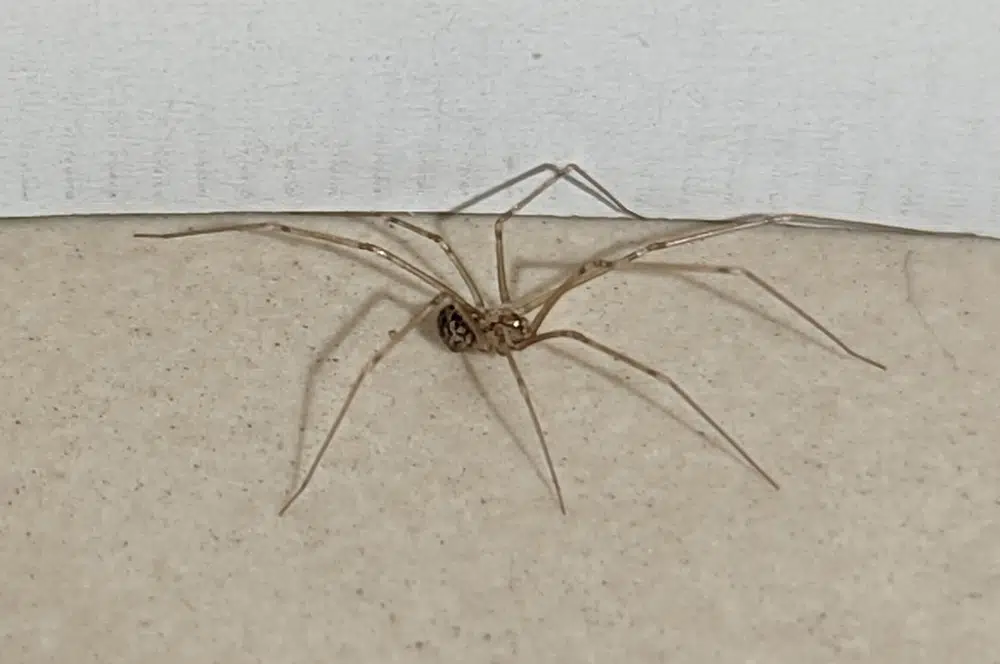
The Short-bodied Cellar Spider (Physocyclus globosus) belongs to the Pholcidae family and is often found in buildings and caves in warmer climates. These are small brown spiders with a broad abdomen and long legs.
They grow to a body length of around 6mm with a black line running down the back of the carapace and abdomen. They have eight eyes, which are together on a bump on the face.
5. Cellar Spider

The Cellar Spider (Pholcus manueli) or daddy long legs is common in the United States, China, Korea, Japan, Russia, and Turkmenistan and are completely harmless to humans. They grow to around 5mm in body length and are smaller than other cellar spiders.
This cellar spider has two dark stripes between the bottom row of eyes and chilicerae with a distinctly divided carapace. These spiders are mostly encountered indoors.
6. Pale Daddy Longlegs Spider
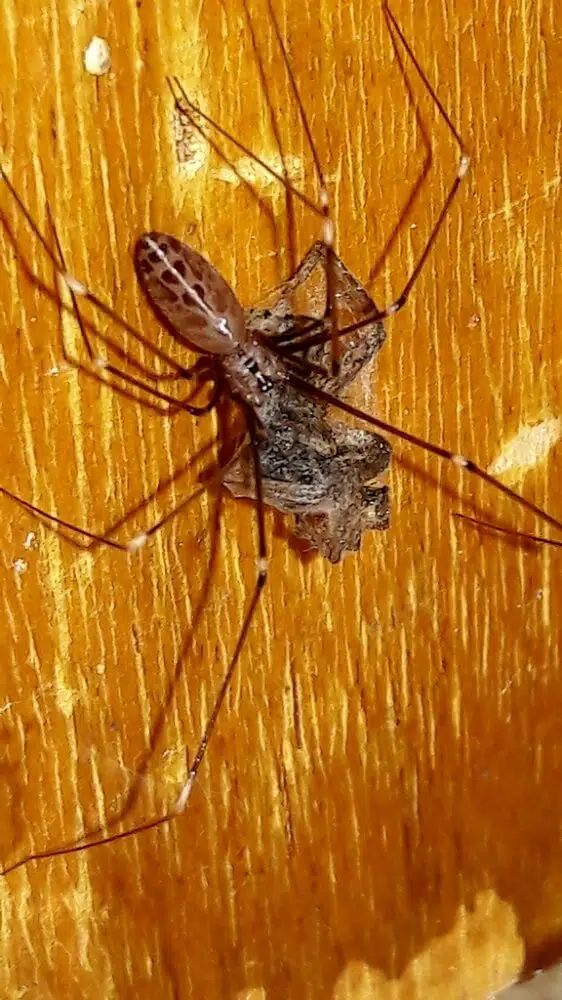
The Pale Daddy Longlegs (Smeringopus pallidus) is a spider that is found in many homes throughout the world. The male is smaller than the females, growing to around 7mm in body length. They have an elongated, cylindrical-shaped abdomen with purple spots on the dorsal surface.
They build irregular cobwebs in hidden areas, capturing small insects and other spiders for food. They are mostly found in dark corners, underdrains, or gardens. They hang upside down in their webs and vibrate when disturbed to confuse any predators.
7. Harvestman Cellar Spider

The Harvestman Cellar Spider (Pholcus opilionoides) can be found in homes in Egypt and Europe with some sightings in Iran. They grow to around 10mm in body length with long legs. There is very little information on this cellar spider.
They have a bulb-shaped abdomen and are uniformly light brown to golden in color, including their spindly legs. They are common around man-made structures where they feed on insects and other spiders.
8. Shortbodied Cellar Spider
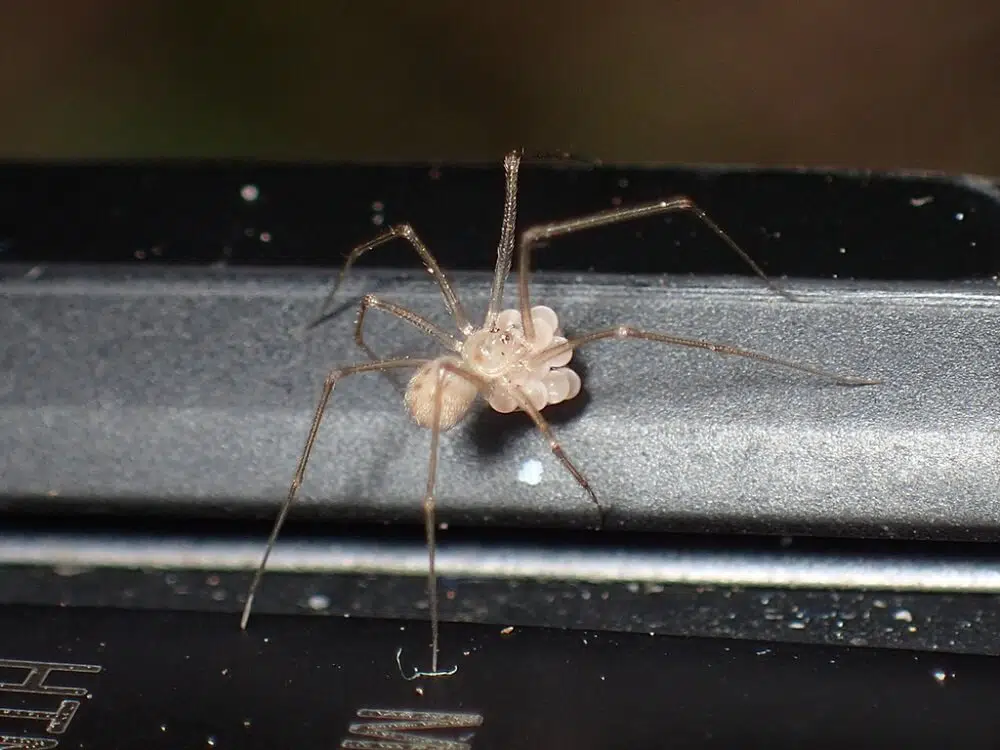
The Shortbodied Cellar Spider (Spermophora senoculata) is from the Polcidae family and has been introduced into the United States, Europe, China, Japan, and Korea. These cellar spiders are harmless to humans, hiding in dark corners where they feed on insects and other spiders.
They are a very pale brown, almost transparent with a bulb-shaped abdomen and long legs.
9. Giant Daddy-long-legs Spider
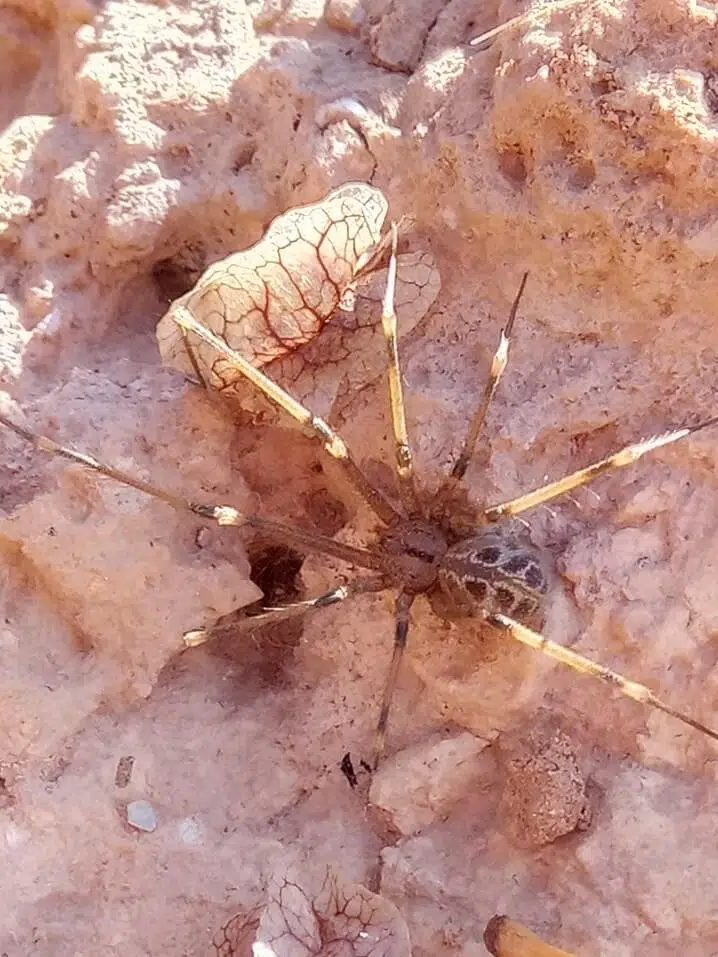
The Giant Daddy-long-legs Spider (Artema atlanta) belongs to the Pholcidae family and is common in Australia and South Africa. These spiders grow to 11mm in body length with their first pair of legs more than six times their body length.
They are common in tropical areas, such as Brazil, Seychelles, Indonesia, and India. They have been introduced to Vietnam, Belgium, North America, and England.
Their spindly legs are longer than a large hand with an abdomen, no bigger than a pea. They are dark-colored and are often encountered in enclosed areas, such as basements attics, mine shafts, and caves.
They create a tangled web to capture insects and other spiders. They have been known to bite, producing local pain. Their venom is exceptionally weak and they are not considered a medical emergency.
They will bounce in their web if you disturb them. This is a way to confuse predators and intruders.
Bonus: Bugs That Look Like Daddy Long Legs
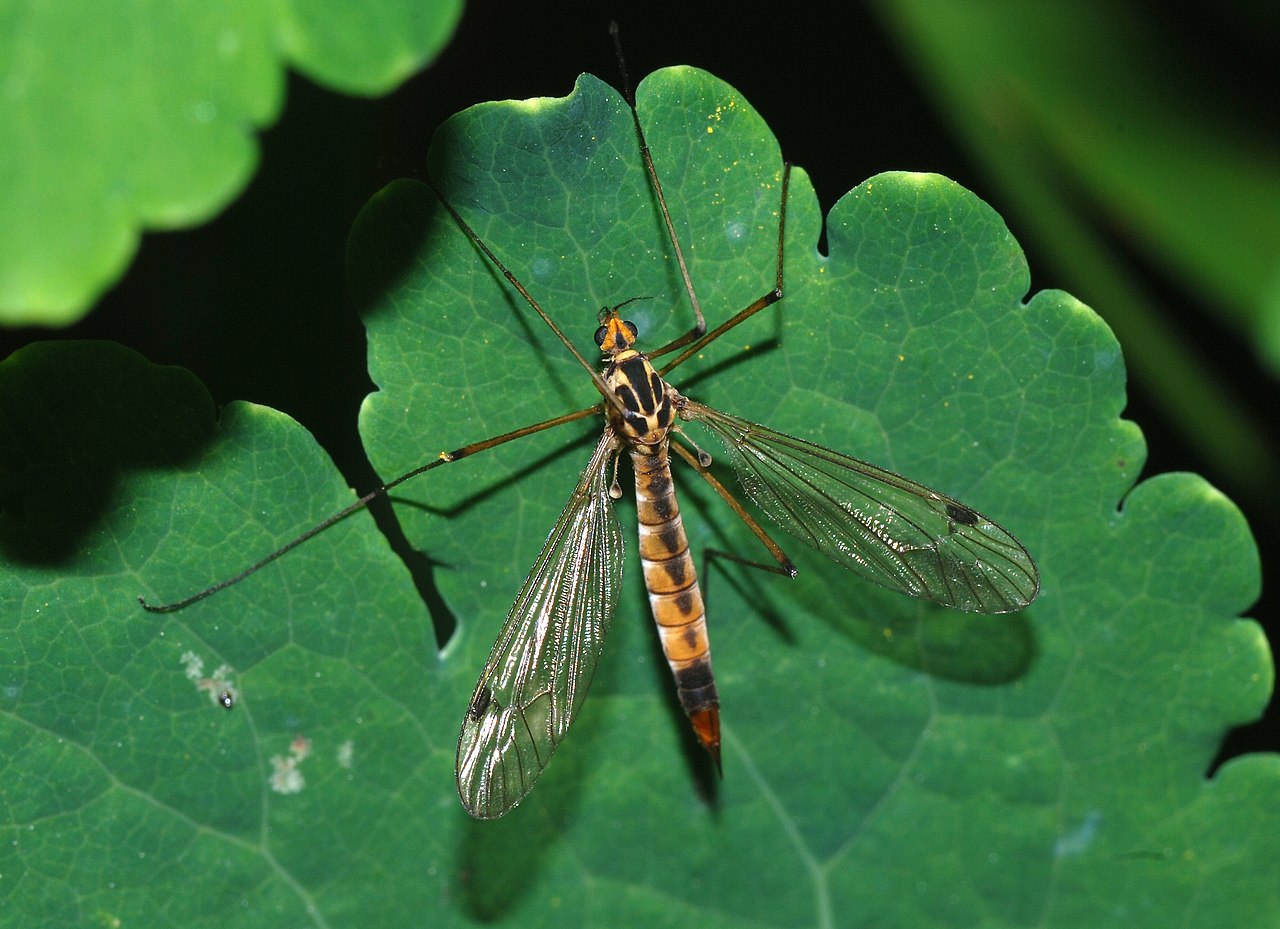
The crane fly is also known as the daddy long legs or mosquito hawk. It looks like a mosquito and is often found indoors, giving it a reputation as a harmful pest. These bugs can be a nuisance, but they do not bite.
They are often confused with cellar spiders or harvestmen. They live in gardens and homes with slender bodies and large wingspans. They are agricultural pests in Europe, where the larvae feed on roots, crowns, and the leaves of crops. This stops the growth or kills the plant, their preferred crops include vegetables, fruits, cereals, pastures, lawns, and ornamental plants.
Summary
The good news is that if you grew up knowing the myth that the daddy long legs is the most poisonous spider in the world, you will be happy to know that this is not the case. The daddy long legs is not a spider at all, and the spiders that resemble the daddy long legs are completely harmless to humans.
Most spiders confused with a daddy long legs are the cellar spiders, all of which prefer hiding in dark and dusty corners, relying on their messy webs to capture insects and other spiders. In fact, they can be beneficial in the home, capturing mosquitoes, flies, and other more dangerous spiders.
Further Reading: